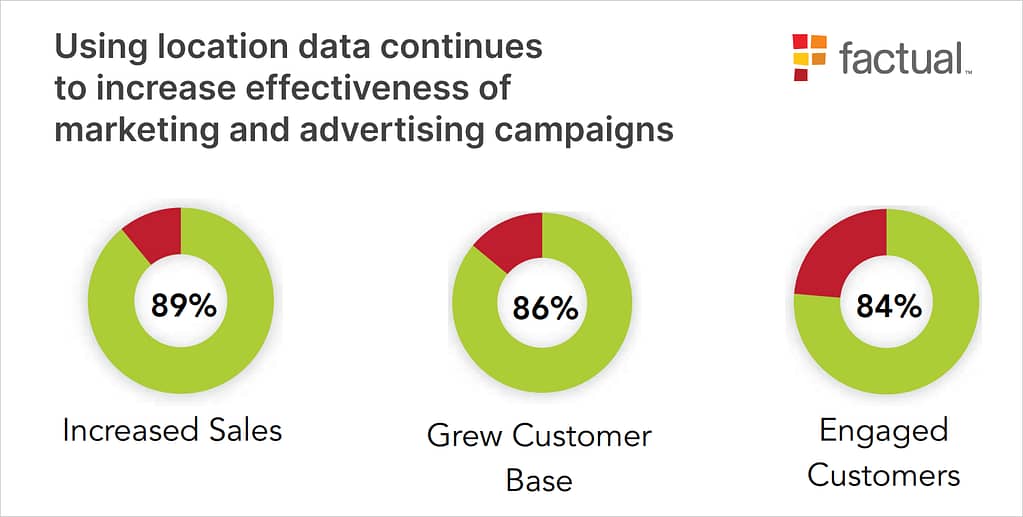What is location targeting?
Location targeting refers to the practice of delivering advertisements to consumers based on their geographic location. This allows advertisers to tailor their messaging to audiences in specific areas, increasing the relevance and effectiveness of their campaigns.
Examples of location targeting
Most large ad platform offer some location targeting options including Google Ads, Meta Ads, and Microsoft Ads and DSPs such as Criteo and MediaMath. Our platform, Fraud Blocker, also offers it.
Here are some visual examples of the feature:
Types of location targeting
- Geo-Fencing: Geo-fencing is highly effective for local businesses, creating a virtual boundary around a specific area. When consumers enter this perimeter, they receive ads tailored to their location. This strategy is particularly beneficial for local events, store openings, or special promotions. For example, a restaurant can set up a geo-fence around its neighborhood, pushing lunch deals to nearby office workers. The immediacy and relevance of geo-fenced ads can significantly boost foot traffic and local engagement.
- Geo-Targeting: Geo-targeting casts a wider net compared to geo-fencing. It allows businesses to target audiences in larger geographic areas like cities or regions, making it ideal for campaigns aimed at broader demographics. This method is used on platforms like Google Ads, and helps businesses promote region-specific products or services (and conversely, allows you to exclude customers outside of specific regions). For instance, a retail chain can use geo-targeting to advertise a region-specific sale, or a service provider can target ads to areas where their service is available, ensuring efficient use of their advertising budget.
- Proximity Marketing: Proximity marketing delivers content to consumers based on their immediate proximity to a business location. Utilizing technologies like Bluetooth and Wi-Fi, this method is highly effective in retail environments. For example, beacons placed in a store can send push notifications about exclusive in-store promotions or product information to customers as they browse, enhancing the shopping experience and encouraging immediate purchases.
- Behavioral Location Targeting: Behavioral location targeting merges location data with analysis of user behaviors, and helps businesses engage with consumers based on their activities within a geographic area. This technique is invaluable for understanding consumer habits and preferences. A business can target users who frequently visit similar types of locations or have shown interest in specific products, leading to more personalized and effective advertising.
How to use location targeting
Better Customer Experience through Precision
Location targeting empowers businesses to enrich the customer experience by providing highly relevant and personalized content. This tailored approach ensures that promotions and messages resonate with the local audience, leading to increased customer satisfaction and loyalty.
Accelerating Sales with Strategic Ad Placement
Effective use of location targeting enables businesses to strategically place ads where they are most likely to generate engagement and sales. This precision in ad placement optimizes advertising spend and drives higher conversion rates, making it an indispensable tool in the marketer’s toolkit.
Personalization: The Core of Location Based Advertising
Personalization in location-based advertising is key to fostering deeper connections with consumers. By aligning ad messages with local culture, events, and a consumer’s behavior, businesses can significantly increase user engagement and build lasting brand loyalty.
Location targeting methods
IP Address Targeting: While IP address targeting doesn’t offer the granular precision of GPS or beacon technology, it’s an invaluable method for broader geographic targeting. By identifying users’ locations based on their IP addresses, advertisers can tailor their campaigns to specific cities, regions, or even countries. This approach is particularly beneficial for online services, e-commerce platforms, and businesses looking to increase their reach in expansive markets, ensuring that their ads are seen by a relevant audience, albeit on a larger scale.
GPS-Based Targeting Techniques: GPS-based targeting represents the pinnacle of precision in location targeting. By harnessing real-time location data, advertisers can reach users with pinpoint accuracy, making this technique particularly potent in mobile advertising. Imagine being able to push a promotional offer to a potential customer who is just a few steps away from your store, or tailoring outdoor ads based on real-time crowd density in a specific area. The immediacy and relevance of GPS-based targeting are unmatched, making it an essential tool in the arsenal of any marketer looking to leverage location to its fullest potential.
Wi-Fi and Beacon Technology: Wi-Fi and beacon technologies take location targeting to a micro-level. By establishing a virtual perimeter around a specific location like a store, event venue, or even a particular aisle within a store, businesses can engage with consumers at a crucial decision-making point. These technologies enable the delivery of hyper-relevant content and offers, significantly enhancing the customer experience. For instance, a customer browsing in a retail store could receive a discount notification on their smartphone for an item they were just looking at, effectively nudging them towards a purchase.
🚨Note: Sometimes users outside your target location see your ads. Learn how to fix location targeting in Google Ads here.
Benefits of location targeting
Personalization at Its Best
The ability to deliver content that aligns with the user’s current context and preferences is one of the most significant benefits of location targeting. This level of personalization enhances the user experience, making interactions with the brand more meaningful and memorable.
Enhanced ROI and Conversion Rates
Effective location targeting leads to better allocation of advertising budgets, as ads are more likely to reach and resonate with the intended audience. This targeted approach results in higher conversion rates and a better return on investment, as advertising efforts are concentrated where they are most effective.
Gaining an Edge in Local Markets
In competitive local markets, location targeting can be the differentiator that sets a business apart. By understanding and catering to local preferences and nuances, businesses can build a strong local presence, earning the loyalty and trust of the community they serve.
Location targeting statistics
The digital advertising landscape is witnessing a significant shift towards location-based advertising. Businesses are leveraging these advancements to deliver more personalized, timely, and relevant advertising to consumers.
A study by Factual underscores the rising importance of location data in marketing strategies, with 90% of marketers stating that location data is a key component of their marketing and advertising strategies. This reliance is not just a trend, but a reflection of the effectiveness of location targeting in connecting with audiences in a more meaningful way.

Location Targeting Effectiveness Metrics
The effectiveness of location targeting can be measured through several key metrics:
- Engagement Rates: According to a report by Business2Community, location-based ads have a higher engagement rate, with click-through rates (CTRs) up to twice as high as non-location-based ads. This indicates that consumers are more likely to interact with ads that are relevant to their current location.
- Conversion Rates: Location-targeted advertising significantly impacts conversion rates. A study by Barilliance found that geo-targeted emails, for instance, see 29% higher open rates and 50% higher CTRs compared to non-segmented emails. This translates to more effective campaigns with higher chances of converting prospects into customers. Learn more about conversion tracking.
- Return on Investment (ROI): The ROI from location-targeted advertising is notably higher. Research from Verve found that location-based mobile strategies can deliver up to 20x return on ad spend, showcasing the financial viability and effectiveness of this approach.





